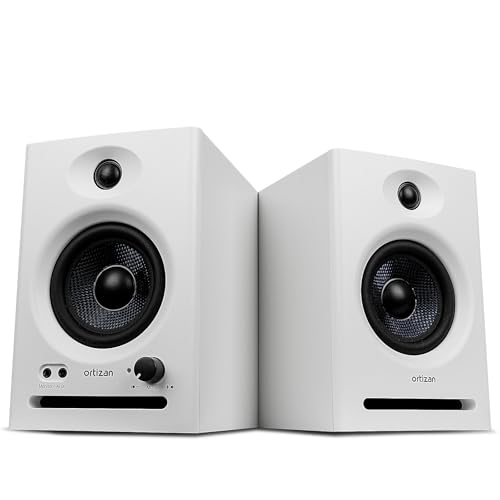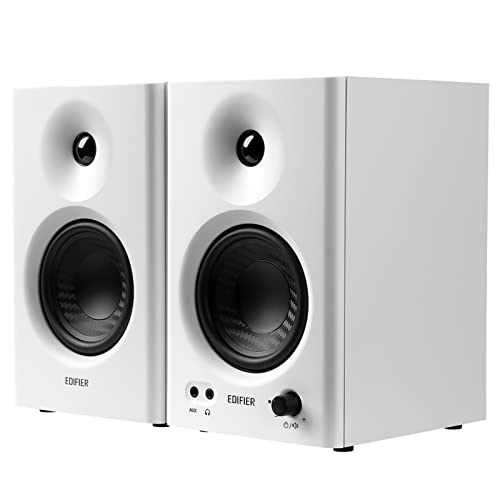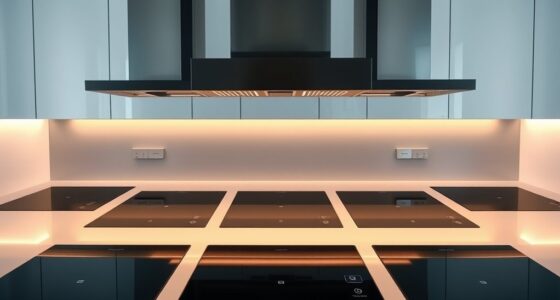If you’re looking for the best studio monitor speakers for crisp, accurate sound in 2025, I’ve got you covered. From compact options like the PreSonus Eris 3.5 to professional-grade monitors like Yamaha HS5 and ADAM D3V, there’s something for every need and budget. These picks offer flat frequency response, solid build quality, and versatile connectivity. Stick around, and I’ll guide you through all the key features to help you choose the perfect pair.
Key Takeaways
- The list features top studio monitors known for delivering crisp, accurate sound tailored for professional mixing and critical listening in 2025.
- It covers various types, sizes, and connectivity options to suit different studio setups and space requirements.
- Emphasis is placed on sound fidelity, flat frequency response, and build quality for reliable, long-term performance.
- The selection includes both powered and passive monitors with diverse features like Bluetooth, USB, and multiple input options.
- Recommendations focus on monitors that balance performance, durability, and compatibility for optimal studio sound accuracy.
PreSonus Eris 3.5 Studio Monitors (Pair)
If you’re looking for compact studio monitors that deliver professional-grade sound without breaking the bank, the PreSonus Eris 3.5 stands out as an excellent choice. These powered, active near-field speakers are perfect for home studios, desktops, or bookshelf setups. They feature a 50W Class AB dual amplifier, providing clear, loud audio without distortion. Equipped with woven-composite 3.5-inch woofers and silk-dome tweeters, they produce tight bass and articulate highs with a neutral sound stage. Multiple inputs, including TRS, RCA, and aux, make connectivity easy. Their sleek design and adjustable acoustic tuning controls ensure tailored sound, making them versatile for music production, multimedia, or casual listening.
Best For: Home studio enthusiasts, multimedia users, and casual listeners seeking compact, accurate sound without high costs.
Pros:
- Compact size with professional sound quality suitable for various setups
- Multiple connectivity options including TRS, RCA, and aux inputs for versatile use
- Adjustable acoustic tuning controls to customize sound response based on room and preference
Cons:
- Build quality and cables may feel average or basic for the price point
- Bluetooth connection can be somewhat inconsistent or quirky at times
- Limited wattage and size may not suffice for larger or more demanding audio environments
YAMAHA Hs5 Powered Studio Monitor, Pair
The Yamaha HS5 Powered Studio Monitor Pair is an excellent choice for professionals and serious hobbyists who need accurate, uncolored sound for critical listening. These near-field monitors feature a 2-way design with a 5-inch cone woofer and a 1-inch dome tweeter, delivering a frequency response from 54 Hz to 30 kHz. With 70W total amplification—45W for lows and 25W for highs—they provide clear, detailed sound without coloration. Equipped with XLR and TRS inputs, they accommodate various connection needs. Their focus on sonic purity makes them ideal for precise audio monitoring in both professional studios and dedicated home setups.
Best For: audio professionals and serious hobbyists seeking accurate, uncolored sound for critical listening and studio monitoring.
Pros:
- Offers precise, flat frequency response for accurate audio reproduction
- Equipped with versatile XLR and TRS inputs for flexible connectivity
- Powerful 70W amplification ensures clear, detailed sound across frequencies
Cons:
- 5-inch woofer may be less suitable for large or expansive spaces
- No built-in Bluetooth or wireless features for easy streaming
- Requires proper placement and acoustic treatment for optimal performance
Yamaha HS3 Powered Studio Monitor in Black, Pair (HS3 B)
For small studios and desktop setups where space is limited, the Yamaha HS3 Powered Studio Monitors in black deliver exceptional clarity with their compact design and high-quality construction. These 7 x 5.2 x 8.8-inch speakers pack a 3.5-inch bass-reflex driver and a 0.75-inch dome tweeter, producing detailed highs and mids. They feature versatile inputs like XLR/TRS, RCA, and stereo mini, along with controls for room response and high trim. Weighing about 13 pounds per pair, they’re sturdy and easy to set up. While they offer limited bass, pairing with a subwoofer enhances low-end performance, making them ideal for nearfield monitoring in tight spaces.
Best For: small studio owners, desktop music producers, and audio enthusiasts seeking compact, accurate monitoring in limited space.
Pros:
- Compact and lightweight design ideal for small spaces and desktop setups
- Clear, detailed sound with accurate high and mid frequencies
- Easy plug-and-play setup with versatile input options (XLR/TRS, RCA, stereo mini)
Cons:
- Limited bass response, often requiring a subwoofer for full-range sound
- Heavy weight (~13 pounds per speaker) may be cumbersome for some placements
- Fixed power cable and no wireless connectivity, reducing flexibility in positioning
Ortizan C7 Dual-Mode Studio Monitors (Pair)
Designed for small rooms, desks, and versatile setups, the Ortizan C7 Dual-Mode Studio Monitors stand out with their impressive wireless connectivity and high-fidelity sound. These active speakers feature a sleek white square design, built from durable ABS, metal, and wood, making them suitable for both indoor and outdoor use. They deliver clear, layered audio with a 3.5-inch carbon fiber woofer and a silk dome tweeter. With multiple inputs—including Bluetooth 5.3, RCA, USB, and AUX—they’re highly adaptable. Easy to set up and praised for their brightness and loudness, they’re a solid all-in-one option for music, gaming, and studio work.
Best For: small room setups, home studios, gaming, and casual music listening enthusiasts seeking high-quality, versatile active monitors with wireless connectivity.
Pros:
- Easy Bluetooth pairing with quick setup and stable connection
- Versatile input options including RCA, USB, AUX, and Bluetooth
- Compact design with powerful sound suitable for various indoor and outdoor environments
Cons:
- Minor volume step size could limit precise control
- Not waterproof, limiting outdoor use in wet conditions
- Slightly larger footprint for very tight spaces
Mackie CR3.5 Creative Reference Studio Monitors
If you’re looking for compact studio monitors that deliver professional-quality sound without breaking the bank, Mackie CR3.5 Creative Reference Studio Monitors are an excellent choice. These powered speakers combine clarity with versatility, making them ideal for music production, multimedia, gaming, or casual listening. They feature a silk dome tweeter and a 3.5-inch woven woofer, providing balanced mids, crisp highs, and solid bass. With multiple input options, switchable modes, and Bluetooth streaming, they’re flexible for various setups. Their sleek design, lightweight build, and straightforward controls make them easy to integrate into any environment, offering impressive sound at an affordable price.
Best For: content creators, home studio users, and casual listeners seeking high-quality, compact studio monitors at an affordable price.
Pros:
- Outstanding sound clarity with balanced mids, crisp highs, and solid bass for its size
- Versatile connectivity options including TRS, RCA, 3.5mm, and Bluetooth streaming
- Compact, lightweight design with professional appearance and easy setup
Cons:
- Limited bass extension without an external subwoofer
- Touch-sensitive controls may require adjustment for some users
- Not ideal for large or professional studio environments due to size and power constraints
Edifier R1280T Powered Bookshelf Speakers
The Edifier R1280T Powered Bookshelf Speakers stand out for their versatile connectivity options, making them ideal for users who want to connect multiple devices simultaneously without hassle. With two AUX inputs—one 3.5mm headphone jack and dual RCA outputs—you can easily switch between your phone, computer, or other sources. The side panel knobs for volume and EQ give precise control over your sound, while the included remote lets you adjust volume from across the room. Featuring a stylish wooden enclosure with a classic finish, these speakers blend well with any decor. Overall, they deliver clear, balanced audio perfect for both casual listening and studio work.
Best For: users seeking versatile, high-quality bookshelf speakers with multiple connectivity options for casual listening, home use, or studio monitoring.
Pros:
- Multiple input options including AUX and RCA for easy device switching
- Precise control over sound with side panel knobs and remote included
- Stylish wooden finish that complements various home decors
Cons:
- Limited to 42 Watts RMS power, which may not suffice for large spaces or high-volume needs
- No built-in Bluetooth or wireless connectivity options
- Controls located only on the active speaker, potentially less convenient for some users
Edifier MR4 Powered Studio Monitor Speakers (Pair)
For those seeking affordable studio monitors that deliver warm, clear sound with flexible connectivity, Edifier MR4 Powered Studio Monitor Speakers stand out as an excellent choice. These 4-inch active near-field monitors feature a sleek bookshelf design in white, with touch controls and multiple wired input options like RCA, AUX, and TRS. They produce a balanced, smooth sound with decent bass and detailed midrange, ideal for casual listening, editing, or light production. The wider soundstage and user-friendly adjustments make them a versatile option for creators on a budget. While lacking wireless features, their build quality and sound profile make them a compelling choice for accurate, engaging audio in 2025.
Best For: casual music listeners, content creators, and light audio editing users seeking affordable, warm-sounding near-field studio monitors.
Pros:
- Warm, clear, and balanced sound profile suitable for a variety of casual and creative uses
- Flexible wired connectivity options including RCA, AUX, and TRS inputs for versatile device compatibility
- Easy-to-access bass and treble controls with touch interface and mode switch for tailored listening
Cons:
- Lack of wireless or Bluetooth connectivity limits convenience and modern device compatibility
- Slightly subdued treble response may require EQ adjustments for detailed high-frequency work
- Build quality, while improved over some models, still may not match high-end monitors and has a non-detachable power cord
ADAM Audio D3V Active Desktop Monitors (Pair, Black)
Designed for near-field listening and desktop use, the ADAM Audio D3V Active Desktop Monitors (Pair, Black) deliver exceptional clarity and deep bass in a compact package. Their iconic golden ribbon tweeters provide precise, fatigue-free high frequencies, while the 3.5” aluminum woofers and dual passive radiators extend low response down to 45 Hz. With adjustable stands, threaded microphone mounts, and versatile connectivity—including USB-C, TRS, and RCA—they’re highly flexible. Built from aluminum, these monitors combine sleek design with solid performance, making them ideal for music production, mixing, or critical listening on a desktop. Users praise their balanced sound and value, despite minor limitations like proprietary cabling.
Best For: musicians, producers, and audiophiles seeking high-quality, compact desktop monitors for near-field listening and studio work.
Pros:
- Exceptional clarity with deep, detailed bass and clear high frequencies thanks to ribbon tweeters and passive radiators
- Versatile connectivity options including USB-C, TRS, and RCA for easy integration with various devices
- Compact, sleek aluminum design with adjustable stands and threaded microphone mounts for flexible setup
Cons:
- Proprietary cabling may limit compatibility and require specific accessories
- Lack of Bluetooth connectivity for wireless audio streaming
- No automatic power sensing, requiring manual on/off management
KRK RP5G5 ROKIT 5 Generation Five 5 Powered Studio Monitor Pair
If you’re looking for studio monitors that deliver precise, balanced sound suitable for critical listening and mixing, the KRK RP5G5 ROKIT 5 Generation Five stands out as an excellent choice. These professional-grade speakers feature a 5” woven Kevlar woofer for detailed bass and modal control, along with a 1” silk dome tweeter extending frequency response up to 40 kHz. Equipped with custom Class D amplifiers and versatile DSP with three Voicing Modes, they optimize sound for different environments. Their sleek, robust design includes acoustic foam wedges and wide compatibility with XLR and TRS inputs. Praised for clarity and accuracy, they’re perfect for both beginners and professionals seeking reliable, high-quality monitoring.
Best For: home studio producers, mixing engineers, and audio enthusiasts seeking accurate and versatile studio monitors for critical listening and professional music production.
Pros:
- Precise, balanced sound with detailed high frequencies and strong bass response
- Custom DSP with multiple Voicing Modes for tailored sound optimization
- Robust build quality with sleek design and versatile input options
Cons:
- Slight brightness from the logo light may be distracting during long sessions
- Not waterproof or water-resistant, limiting outdoor or rugged use
- Larger footprint (~9.45”D x 7.09”W x 10.43”H) may require ample space in smaller setups
M-AUDIO BX3 Studio Monitors (Pair, 3.5″, 120W)
The M-AUDIO BX3 studio monitors stand out as an excellent choice for entry-level producers, content creators, and gamers seeking reliable, crisp sound without breaking the bank. These pair of 3.5-inch, 120W monitors deliver clear audio with deep, rich bass thanks to their bass reflex design and Kevlar drivers. Compact and stylish, they’re easy to set up and connect via RCA, 1/4”, or 1/8” inputs, making them versatile for various devices. While ideal for casual, nearfield use, they offer adjustable EQ controls for personalized sound but aren’t suited for professional mixing. Overall, they’re a solid, budget-friendly option for reliable multimedia and gaming audio.
Best For: entry-level producers, content creators, and gamers seeking affordable, reliable nearfield studio monitors with versatile connectivity and rich sound.
Pros:
- Compact, stylish design with easy setup and versatile input options
- Delivers clear, balanced sound with deep bass and high-end clarity
- Affordable price point with good build quality and positive user reviews
Cons:
- Not suitable for professional studio mixing or mastering environments
- Auto sleep mode may be unreliable, requiring manual intervention
- Excessive bass or treble adjustments might be necessary for personal preferences
JBL 305PMkII Studio Monitor Speaker
The JBL 305PMkII Studio Monitor Speaker stands out for its updated transducers and optimized damping, delivering superb transient response, deep bass, and low harmonic distortion. Its next-generation HF and LF drivers provide a neutral, broad soundstage, making it ideal for near-field listening and precise mix adjustments. The sleek design adds a modern touch to any studio setup, while the Boundary EQ feature helps restore accurate low-frequency response when placed near walls or surfaces. Included accessories like peel-off rubber pads ensure stable placement, and the overall build quality emphasizes clarity and detail. This monitor really excels in delivering professional-grade sound in both studio and home environments.
Best For: music producers, audio engineers, and home studio enthusiasts seeking accurate near-field monitoring with professional sound quality.
Pros:
- Updated transducers and optimized damping provide superior transient response and deep bass.
- Broad sweet spot with neutral frequency response for precise mixing even off-axis.
- Modern design with Boundary EQ feature to restore accurate low-frequency response near surfaces.
Cons:
- Sold individually, so purchasing a pair requires two units.
- No waterproofing, limiting outdoor or rugged use.
- May be more expensive than basic consumer speakers, suitable primarily for professional or serious hobbyist use.
Pioneer DJ DM-50D 5-inch Active Monitor Speaker – Black
For DJs and home studio enthusiasts seeking reliable, high-quality sound, the Pioneer DJ DM-50D 5-inch Active Monitor Speaker stands out with its powerful bass and crisp clarity. Its 5-inch woofer and 3/4-inch dome tweeter deliver balanced, studio-grade audio, capable of high volume without distortion. The monitor’s front-level knob, DSP switch for production or DJ modes, and app control make adjustments straightforward. Compact yet robust at 7D x 11W x 10H inches and 16 pounds, it’s compatible with desktops, laptops, and mobile devices. Customers praise its durability, excellent bass, and compatibility, making it a versatile choice for various audio setups.
Best For: DJs, music producers, and home studio enthusiasts seeking high-quality, powerful sound with clear bass and crisp audio.
Pros:
- Delivers studio-grade sound with balanced frequencies and strong bass
- Easy to operate with front-level knob, DSP switch, and app control
- Compact and durable design suitable for various setups and portable use
Cons:
- Slightly higher price compared to basic monitor options
- No included MP3 player or external audio source, requiring separate devices
- Some users desire a dedicated on/off switch instead of relying on the front level knob
SW208 3 Active Bluetooth 5.0 Bookshelf Speakers
If you’re looking for compact speakers that deliver rich, accurate sound without taking up much space, Sanyun’s SW208 3 Active Bluetooth 5.0 Bookshelf Speakers stand out. These stylish, lightweight speakers feature a premium wood finish and a 3-inch dynamic driver per unit, producing warm midrange, deep bass, and bright highs. With 60W total power and multi-layer voice coil technology, they fill small rooms with clear, detailed audio and impressive bass. Bluetooth 5.0 guarantees stable wireless connectivity, while multiple inputs and adjustable controls offer versatile setup options. Perfect for desktops, gaming, or multimedia, SW208 combines sleek design with high-fidelity sound, making it an excellent budget-friendly choice.
Best For: anyone seeking compact, high-quality bookshelf speakers for desktop use, gaming, or multimedia entertainment on a budget.
Pros:
- Delivers warm midrange, deep bass, and bright highs with clear, detailed sound.
- Compact and stylish design that fits well in small spaces and modern setups.
- Versatile connectivity options including Bluetooth 5.0, USB, auxiliary, and wired subwoofer input.
Cons:
- Not waterproof, so unsuitable for outdoor or damp environments.
- May require adjustments of bass and treble for optimal sound preferences.
- Limited to indoor use due to size and design.
Edifier MR5 2.0 Studio Monitor Bookshelf Speakers
Edifier MR5 2.0 Studio Monitor Bookshelf Speakers stand out as an excellent choice for those seeking studio-grade sound in a compact design. They feature a 3-way active crossover with a 5-inch woofer, 3.75-inch mid driver, and silk dome tweeter, offering a frequency response of 46Hz–40kHz. With Hi-Res Audio support via wired and wireless connections, they deliver crystal-clear, detailed sound. Their 110W RMS Class D amp provides enough power for near-field studio environments. The speakers offer versatile connectivity, including Bluetooth 6.0, XLR, RCA, and front headphone jack, plus app-based EQ and physical controls for personalized tuning.
Best For: audiophiles, home studio users, and casual listeners seeking high-quality, versatile bookshelf speakers with studio-grade sound.
Pros:
- Studio-grade sound with detailed high-resolution audio support and wide frequency response
- Versatile connectivity options including Bluetooth 6.0, XLR, RCA, and app-based EQ controls
- Compact design with sturdy build quality suitable for various indoor settings
Cons:
- Volume may be insufficient at high levels for larger or noisy environments
- Inputs are always active simultaneously, limiting easy switching between sources
- May benefit from a subwoofer for full-range sound and deeper bass performance
Factors to Consider When Choosing Studio Monitor Speakers

When selecting studio monitor speakers, I focus on sound accuracy and clarity to guarantee my mixes translate well. I also consider the frequency response range, connectivity options, size for my space, and the power needed to drive them effectively. These factors help me choose monitors that fit my setup and deliver the precise sound I need.
Sound Accuracy and Clarity
Achieving true sound accuracy and clarity is vital when selecting studio monitor speakers, as these qualities guarantee your mixes are reliable and true to the original audio. Sound accuracy depends on a flat frequency response, ensuring no part of the spectrum is exaggerated or diminished. Clarity relies on high-quality components like silk dome tweeters and woven woofers, which deliver detailed, precise sound without distortion. Near-field monitors designed for close listening reduce room reflections and acoustic interference, enhancing clarity. The absence of tonal bias or coloration is essential for accurate mixing, allowing you to make true-to-life adjustments. Additionally, reliable monitors reproduce sound consistently across different angles and distances, providing a dependable reference for critical audio work.
Frequency Response Range
The frequency response range of studio monitor speakers is a key factor because it determines which sounds they can accurately reproduce. A wider range allows me to hear both deep bass and crisp high treble, which is essential for critical listening and mixing. Most monitors cover from about 40-70 Hz up to 20-30 kHz, matching the full spectrum of human hearing. An extended and flat response ensures the sound remains neutral, without emphasizing or de-emphasizing certain frequencies. This neutrality helps me make precise adjustments during mixing, knowing the monitor isn’t coloring the sound. Variations in frequency response can impact how accurately a monitor mimics real-world audio, influencing both clarity and the integrity of my mixes. In short, a suitable range is vital for true-to-life sound reproduction.
Connectivity Options
Choosing the right connectivity options is essential because it determines how easily my studio monitors integrate with my existing gear. I look for monitors with balanced XLR and TRS inputs, which provide cleaner signals and reduce noise. Unbalanced RCA inputs are common but can be more susceptible to interference, so I consider how my cables will be routed. Some monitors now include digital options like USB or Bluetooth, making it simple to connect directly to my computer or stream wirelessly from devices. Multiple input channels are a bonus, allowing me to switch between sources effortlessly. I also pay attention to cable placement to avoid interference and signal loss. Ensuring compatibility with my current equipment is key to building a seamless and reliable studio setup.
Size and Space Fit
When selecting studio monitor speakers, size plays a essential role in guaranteeing they fit comfortably within your space and deliver peak performance. The dimensions and weight of the monitors influence how easily they can be positioned at ear level and how well they integrate with your setup. Compact models, usually under 6 inches in driver size, are ideal for small desks or limited spaces but might lack deep bass. Larger monitors with bigger drivers require more room and may need additional acoustic treatment to prevent sound reflections. It’s imperative to create an ideal listening triangle, positioning your monitors at the right distance and angle. Proper sizing ensures you get accurate sound without overwhelming your space, making your mixing and listening experience more precise and enjoyable.
Power and Amplification
Selecting the right studio monitor involves more than just size; understanding power and amplification is key to achieving accurate sound. The wattage a monitor produces determines how loud it can go and how much headroom it has for dynamic passages. Amplification quality impacts sound clarity, especially at higher volumes, ensuring your mixes remain transparent. Powered monitors with built-in amps often deliver more consistent performance than passive models, which need external amplification. The balance between wattage and speaker sensitivity affects how efficiently a monitor converts power into sound, influencing overall volume and detail. Too much power can cause distortion, while insufficient power may result in a lack of punch and clarity. Getting this balance right ensures your monitors perform reliably across a range of listening levels.
Build Quality and Durability
Build quality and durability are critical factors that determine how well studio monitor speakers withstand daily use and environmental stresses. I look for monitors with sturdy enclosures made from MDF wood or metal, as these materials resist warping and damage over time. Reinforced corners, vibration-resistant components, and high-grade internal wiring help prevent issues caused by extended use or high volumes. The quality of controls, tightness of joints, and overall finish also reveal craftsmanship and durability. Detachable or reinforced grilles protect drivers from dust and impacts, extending lifespan. A well-built monitor maintains consistent sound without rattles or vibrations, even after long sessions. Choosing monitors with solid construction ensures longevity and reliable performance, making them a smart investment for any serious studio setup.
Room Acoustics Compatibility
Room acoustics play a crucial role in how accurately your studio monitor speakers perform, as reflective surfaces and room dimensions directly influence sound clarity and stereo imaging. When monitors are placed too close to walls or corners, they can produce exaggerated bass, distorting your mix. Acoustic treatment, like bass traps and diffusers, helps reduce resonances and standing waves, improving sound quality. The size and shape of your room also impact how monitors should be positioned and calibrated for a balanced, neutral soundstage. Adjusting the placement, angle, and height of your monitors in relation to your room’s acoustics can markedly enhance sound dispersion and minimize acoustic anomalies. Paying attention to these factors ensures your monitors deliver the most accurate, reliable audio for mixing and critical listening.
Budget and Value
Choosing the right studio monitor involves balancing your budget with the features and performance you need. I recommend setting a clear budget range and comparing monitors within that limit to focus on value rather than unnecessary extras. Consider the cost-to-performance ratio—look for monitors that deliver accurate sound relative to their price. Higher-priced models often offer better build quality and precision, but affordable options can still be excellent for casual or entry-level use. Don’t forget to factor in additional costs like stands, cables, or subwoofers when evaluating overall value. Reading customer reviews and expert opinions helps determine if a monitor’s performance justifies its price and offers good long-term value. Prioritizing these factors ensures you get the best sound within your budget.
Frequently Asked Questions
How Do Room Acoustics Impact Studio Monitor Performance?
Room acoustics profoundly impact my studio monitor performance by affecting sound clarity and accuracy. Poor acoustics cause reflections, echoes, and standing waves that distort the audio I hear. To get the best sound, I treat my room with bass traps, diffusers, and absorbers, which minimize unwanted reflections. This helps me hear a truer representation of my mix, ensuring my monitors perform at their best and my recordings sound professional.
Are There Portable Studio Monitors Suitable for Mobile Setups?
Think of portable studio monitors like reliable travel companions—they’re built to go wherever your music takes you. Yes, there are great options designed for mobile setups, like the Yamaha HS5 or JBL 305P MkII. I’ve used them on the go, and they deliver crisp, accurate sound without sacrificing convenience. If you need quality on the move, these monitors are a solid choice to keep your sound professional anywhere.
Which Monitors Offer the Best Connectivity Options for Modern Devices?
If you’re looking for monitors with the best connectivity for modern devices, I recommend models with multiple inputs like USB, Bluetooth, and XLR or RCA. I personally prefer monitors that offer seamless wireless streaming and versatile wired options, so I can connect easily to my laptop, tablet, or smartphone. Features like Bluetooth 5.0 and USB-C guarantee quick, reliable connections, making my workflow smooth and hassle-free.
How Important Is Speaker Placement for Optimal Sound Accuracy?
Think of speaker placement as setting the stage for a perfect performance. It’s essential for sound accuracy because slight adjustments can turn a muddy mix into a crystal-clear masterpiece. I always listen carefully and experiment with positioning, ensuring monitors form an equilateral triangle with my ears. Proper placement minimizes reflections and phase issues, allowing me to hear every detail as if I’m right there in the studio, making my mixes truly shine.
What Are the Long-Term Durability Considerations for Studio Monitors?
I believe long-term durability is vital when choosing studio monitors. I always look for models with robust enclosures, high-quality components, and good heat dissipation to prevent overheating. Regular maintenance, like keeping them dust-free and avoiding excessive volume levels, also helps extend their lifespan. Investing in well-built monitors ensures consistent, accurate sound over years, saving me from frequent replacements and maintaining my audio quality without interruption.
Conclusion
Choosing the right studio monitor speakers can feel overwhelming, but remember, it’s about finding what sounds best to you. Don’t worry if you’re on a budget or new to this—there are great options at every price point. Trust your ears, and you’ll discover the perfect pair that brings your music or projects to life. After all, the best monitor is the one that makes you want to keep creating.

























